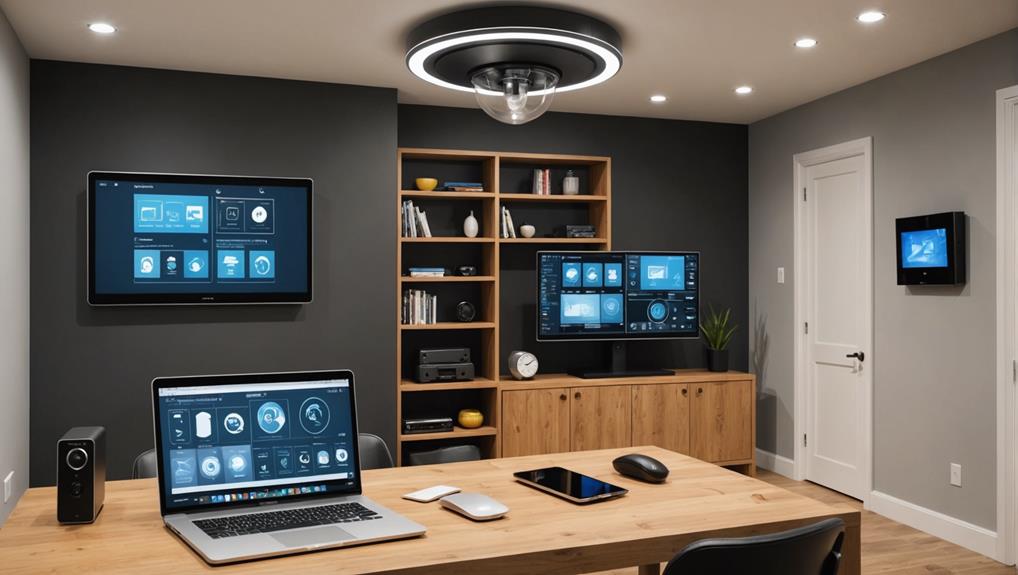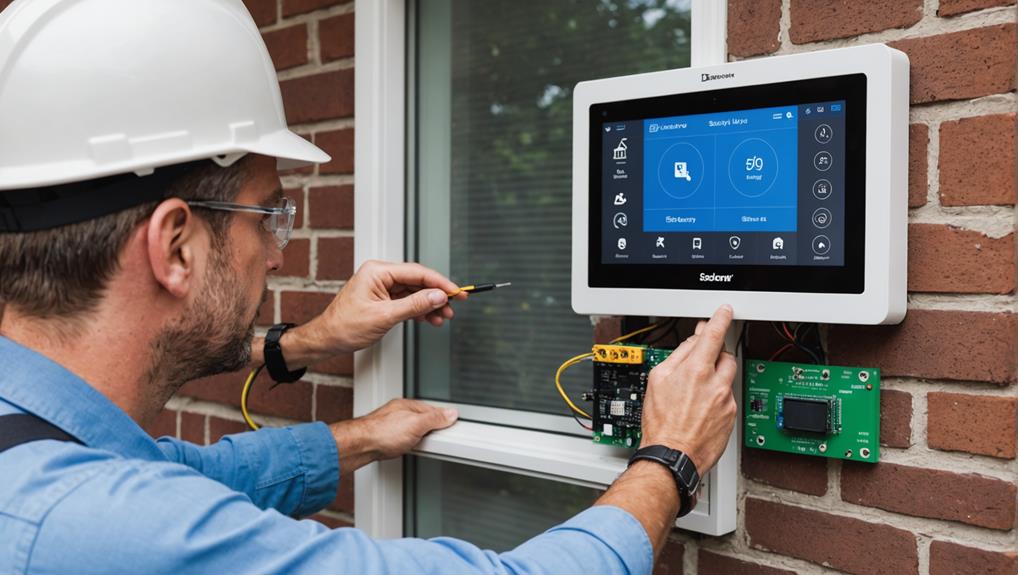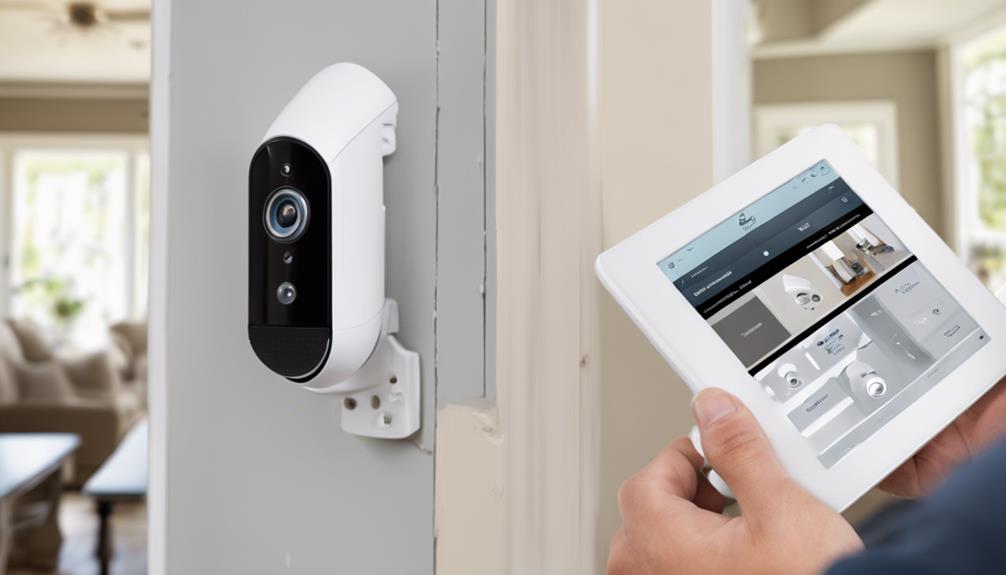When considering DIY versus professional security systems, it all boils down to your needs. DIY setups give you control over installation, cost savings upfront, and customization options tailored to your preferences. They let you avoid installation fees and offer self-monitoring without extra costs. However, professional systems come with expert installation, monitoring, and rapid response services, providing peace of mind. Deciding between the two depends on how hands-on you want to be and your budget. Understanding the differences in installation, costs, monitoring choices, and customization will help you make the right decision for your home security.
Key Takeaways
- DIY systems offer customization, cost savings, and flexibility.
- Professional systems provide expert installation, monitoring, and support.
- Consider DIY for budget-conscious consumers seeking control and personalization.
- Choose professional setups for reassurance, comprehensive monitoring, and expert installation.
- Evaluate needs, budget, and technical comfort to determine the best security system fit.
Installation Process Comparison

Curious about how DIY and professional security system installations measure up?
DIY security systems offer a quick setup of 30 minutes to 2 hours, allowing you to customize sensor placement and the installation process. You can find peel-and-stick command strips widely available for convenient mounting.
Professional installation, on the other hand, typically takes 2-4 hours, with technicians guaranteeing ideal equipment placement and functionality, reducing the risk of installation errors.
DIY systems come with easy peel-and-stick command strips for mounting, but durability may require brackets due to potential adhesive loss over time.
While professional installation fees start around $100 and vary based on system complexity, many DIY systems have no installation fees.
Professionals conduct post-installation testing to verify all components work correctly, whereas DIY installations require users to test the system themselves for functionality.
Consider your priorities for convenience, customization, and cost when deciding between DIY and professional home security installation.
Cost Analysis and Savings

When considering security systems, cost plays a significant role in your decision-making process.
DIY options often present lower upfront costs compared to professional systems, potentially saving you hundreds of dollars.
However, it's important to factor in the long-term expenses associated with each option to get a full picture of the financial commitment.
Understanding the financial implications and benefits of each choice is vital for making a cost-effective and financially sound decision for your security needs.
Cost-Effectiveness of Options
For those considering home security options, comparing the cost-effectiveness of DIY versus professional systems is essential.
DIY home security systems typically start at around $200, making them a more budget-friendly option compared to professional systems, which can range from $200 to $1,000 for installation and equipment.
Professional monitoring services often come with monthly fees ranging from $20 to $60, while many DIY systems allow for self-monitoring at no additional cost.
With an average installation fee of about $150 for professional systems, DIY setups eliminate this cost entirely, resulting in significant overall savings.
Long-term savings potential with DIY systems can amount to hundreds of dollars when factoring in the absence of contracts and ongoing fees.
Additionally, customizable DIY packages enable homeowners to save on equipment costs by tailoring their security setup to individual needs and budgets, unlike the fixed packages commonly offered by professional security companies.
Consider these cost factors when deciding between DIY and professional security options.
Long-Term Savings Potential
Considering the cost-effectiveness of DIY versus professional security systems, it's important to explore the long-term savings potential.
When deciding which security system to choose, keep in mind that DIY options typically have lower upfront costs, saving you hundreds compared to professional systems.
Professional security systems often entail long-term contracts with monthly monitoring fees ranging from $20 to $60, which can accumulate over time, impacting your overall expenses considerably.
In addition, professional installation costs, ranging from $200 to $1,000, make DIY systems more appealing for those seeking to avoid additional expenses.
By opting for a self-monitoring DIY system, you can avoid recurring monitoring fees, further contributing to long-term savings.
The flexibility of DIY systems also allows for customization and upgrades without the limitations of a professional package, potentially leading to more savings in the future.
Keep these factors in mind when considering the long-term financial implications of DIY versus professional security systems.
Financial Considerations and Benefits
Opt for DIY security systems to maximize your cost savings and financial benefits. With DIY options starting at around $200, you can save greatly on upfront costs compared to professional systems that can range from $200 to $1,000 for installation alone.
Professional monitoring services often come with monthly fees ranging from $20 to $60, while DIY systems offer self-monitoring options with no ongoing costs. By choosing a DIY installation, you could save hundreds of dollars by avoiding installation fees and long-term contracts associated with professional systems.
Additionally, DIY setups allow for customization and future expansion, leading to long-term savings through tailored solutions. Consider refurbished devices in the DIY market to further reduce costs, making security accessible to budget-conscious consumers without compromising essential features.
Embracing a DIY approach to security not only saves you money but also offers flexibility and control over your system, ensuring cost-effectiveness without sacrificing quality.
Monitoring Options Overview

When comparing DIY and professional security systems, the monitoring options available play an essential role in determining the level of protection and support you receive. Here's what you need to know:
1. Peace of Mind: Professional monitoring services offer 24/7 surveillance, ensuring rapid response to alerts and emergencies. This constant oversight can bring peace of mind knowing that someone is always looking out for your safety.
Additionally, professional systems often come with integrated features like fire and carbon monoxide detection, enhancing your overall security.
2. Cost Considerations: While professional monitoring typically comes with a monthly fee ranging from $20 to $60, some DIY options provide budget-friendly self-monitoring with no ongoing costs.
Consider your budget and the level of service you require when making a decision. It's also worth noting that some DIY systems provide flexible contracts, which can be an advantage if you don't want to commit to long-term agreements.
3. Flexibility and Support: DIY systems may offer optional professional monitoring as an add-on, allowing you to customize your security setup based on your needs.
Keep in mind that professional security systems often include dedicated support teams for troubleshooting, while DIY systems may have more limited customer service options.
Consider these factors when choosing the monitoring option that best suits your needs and budget.
Feature and Customization Breakdown

Looking at the breakdown of features and customization options between DIY and professional security systems sheds light on the diverse capabilities each type offers.
DIY systems, like those from Ring and SimpliSafe, allow you to personalize your security setup by choosing specific devices and sensors based on your unique requirements. This customization often results in a more tailored security experience, accommodating a range of preferences and budgets. Additionally, DIY systems can be advantageous for those who prefer to avoid installation fees and have the flexibility to upgrade components as new technology emerges.
On the other hand, professional security systems typically provide all-inclusive packages with advanced features such as smart cameras, connected deadbolts, and 24/7 monitoring. However, customization options may be more limited compared to their DIY counterparts, as users are usually required to select from pre-established kits due to installation fees that can average around $200.
DIY systems offer the flexibility to build your own kit, with starter packages priced between $200 to $500, while professional systems may have higher monthly monitoring fees, starting from $45 to $60, limiting customization options and potentially increasing ongoing costs.
Market Insights and Trends

You'll find that the U.S. home security market is on a steady rise, with projections indicating significant growth to reach $78.9 billion by 2024.
DIY security systems are particularly gaining traction, showing an impressive annual growth rate of around 20% through 2025.
There are many affordable security devices available that cater to various needs and budgets.
Consumer trends are pointing towards a preference for customizable and budget-friendly options, with a shift towards self-monitoring solutions and flexible plans that don't tie you down to long-term contracts.
Market Growth Analysis
Experiencing a surge in growth, the electronic security installation industry in the U.S. is poised to expand substantially, with a projected market size of $78.9 billion by 2024.
As you navigate the evolving landscape of security systems, here are key insights to contemplate:
- Excitement: The industry's rapid growth promises an array of innovative solutions to safeguard your home and loved ones effectively.
- Empowerment: With DIY options on the rise, you have the opportunity to take control of your security needs, tailoring systems to suit your preferences and budget.
- Peace of Mind: Whether opting for DIY setups or professional installations, the overarching goal remains the same – providing you with a sense of security and peace of mind in an ever-changing world.
Consumer Preference Trends
With the electronic security installation industry in the U.S. experiencing significant growth and consumer preferences shifting towards more customizable and cost-effective solutions, it becomes apparent that market insights and trends play an essential role in shaping the choices homeowners make regarding their security systems.
The projected 20% annual growth in the DIY security system market through 2025 reflects increasing consumer interest in self-installed solutions. Budget constraints often drive consumer preferences, with DIY systems costing 2-3 times less than professionally installed alternatives.
Home security demand is fueled by approximately 1 in 36 homes experiencing a burglary annually. While professional services offer thorough monitoring and installation packages, appealing to those with limited technical skills or time, there's a growing trend towards integrating smart home features into security systems.
This trend influences consumer choices, steering them towards technology-capable solutions for their home security needs. Stay informed about these evolving consumer preference trends to make the right security system decision for your home.
Home Security System Overview

An essential aspect of protecting your home and loved ones is investing in a reliable home security system. When evaluating your options, it's critical to understand the different types available and their features:
1. DIY Systems: These empower you to take control of your home security, offering flexibility and customization to suit your needs. They can be a cost-effective solution for those willing to set up and monitor their system independently.
However, it's important to reflect on potential challenges such as technical difficulties and the learning curve associated with installation.
2. Professionally Installed Systems: With trained technicians managing the installation and monitoring, these systems provide a thorough approach to home security.
While they may involve higher upfront costs and monitoring fees, they offer peace of mind and professional expertise.
3. Monitoring Services: Whether you opt for a DIY or professional system, monitoring services play an essential role in ensuring a prompt response to any security threats.
Choose a monitoring plan that aligns with your budget and security requirements, prioritizing the safety of your household.
Frequently Asked Questions
Are DIY Security Systems Worth It?
Yes, DIY security systems can be worth it for many people.
They offer cost-effective options with easy setup, customization, and no installation fees. You can tailor the system to fit your needs and save money in the process.
While they may lack some features of professional systems, DIY options often provide affordable monitoring without long contracts.
Consider your priorities and budget to determine if a DIY security system is right for you.
What Is the Difference Between ADT and DIY?
When considering the difference between ADT and DIY security systems, it's essential to note that ADT offers professional installation and monitoring services but comes with higher costs and long-term contracts.
On the other hand, DIY systems provide flexibility and no contractual obligations, allowing you to customize your setup at a lower initial investment.
Understanding your priorities and budget will help you choose the security system that best fits your needs.
What Is the Best Do It Yourself Home Security System?
When choosing the best DIY home security system, consider factors like cost, customization, and ease of installation.
Look for options like SimpliSafe and Ring with affordable starting prices and expandable features.
Devices such as the Google Nest Cam offer high-quality video and motion alerts.
With user-friendly setup guides, most DIY systems can be installed in 1-3 hours.
Enjoy the flexibility of self-monitoring and the choice of adding professional monitoring services.
What Type of Security System Is the Best?
When deciding on the best security system for you, consider your needs, budget, and preferences.
Assess the level of customization, installation time, and monitoring services that align with your lifestyle.
Research DIY and professional options to determine which offers the features you value most.
Prioritize security and peace of mind when making your choice.
Conclusion
When deciding between a DIY or professional security system, consider your comfort level with installation, budget, and monitoring needs. DIY systems offer cost savings and customization, while professional systems provide professional installation and monitoring services. Choose the option that aligns best with your preferences and priorities to guarantee the safety and security of your home.









